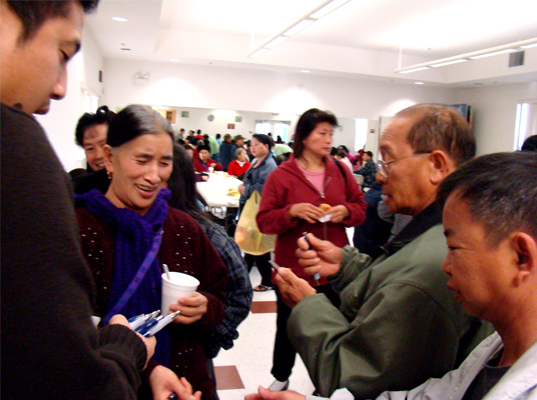This week’s affiliate soup is piping hot and conversions never tasted so good. If you’ve ever seen Joel McHale’s weekly recap of completely useless pop culture garbage called ‘The Soup’ then you get the idea. Straight from the twitter pipeline is your top affiliate tweets of the week. Condensed and served hot. No fucking gazpacho here, so please don’t burn your poor little affiliate tongues.
Is the Google +1 button pissing anyone else off? I don’t know what it is about that flashy little fucker, but it infuriates me. Anyways, tracking social conversions has been on the radar for quite some time now. Facebook likes, Twitter follows, Google +1 are some of the hot buttons for landing pages. Have you already slapped these social buttons on your landing pages? Are you tracking them? Here’s what I’m getting at…If you aren’t tracking social behaviors then you’re missing out on a massive opportunity for social promotion which will subsequently increase your ROI. While most social sharing buttons can easily be added to your pages by inserting a little snippet of code, you can’t exactly track the engagement. A “Callback Function” is needed to record social conversions so that you can accurately monitor your clicker’s interactions.
Track Google +1 actions here.
Track ‘Like’ actions here.
Track ‘Follow’ events – get the block of code here.
Search engine land provides a kickass article on how to track social conversions on your landing pages. If you want to read more about this post-click marketing delight and get some handy dandy links to APIs and blocks of code, click here.
We fail to fail. That’s right, we never allow ourselves to fail. Not failing is the biggest mistake we can make as marketers. Most of us are apprehensive when it comes to making drastic changes in testing, and we tend to guess which elements will work and which will not work. Turns out that failing to take risks in testing will actually result in failed campaigns. Sound like a bunch of marketing mumbo-jumbo to you? It’s really not. There’s a science involved in our practice and failure is an essential part of the process.
However, it’s very important to pick and choose your failures. Remember when you were little and your parents told you not to bite off more than you can chew? Take the same approach when it comes to testing elements on your landing pages. Test one element at a time, instead of making major changes all at once – which will inevitably lead to failure. You’ll see greater results by exercising more caution in the way you test. Don’t get this concept confused with not testing as often, but learn to test elements strategically and leave the guesswork to Mr. A and Mr. B (a/b testing). Although you’d like to think you’re the Lebron James of marketing, sometimes you have to let technology take the reigns. So, go ahead…Crash and burn. Black out and don’t look back. Hit rock bottom. Fail and fail again. You get the point. Clickz does, too.

Faces don’t perform well in online ads. Who woulda thunk it? All this time our Shutterstock account has been loaded up with bikini-clad women, cookie-cutter business men, and token middle class families. All for nothing? “Only one of the top five ads tested featured a person, compared to three of the bottom performing ads that did, according to a study Yahoo has published called ‘Capitalizing on the Creative Canvas.’” It turns out that competing facial images and unappealing faces distract viewers from key messages, halting the conversion process. It pays to be pretty then? Apparently not. Let’s face it, high contrast designs are the new black when it comes to generating clicks. What to do with the rest of your ads’ features? They suggested placing buttons near elements that hold strong emotional appeal (immediate results, instant gratification, huge savings, or exclusivity). Where do your eyes go when you look at a landing page? Do you scan left to right? Top to bottom? Turns out consumers typically scan pages right to left and middle to top. To find out what kind of ads generate the best CTRs, check out Marketing Vox’s latest conversion-crunching article here.
If your landing pages aren’t converting, you must read this article. I’ve had enough of those articles preaching how to build amazing landing pages <–sorry for the shameless self plug. SEOmoz does a much better job mapping out optimization techniques that will honestly and truly boost your conversions. From heat maps, pre-populating cursors, point of action assurances and testimonials to keyword relevance, ad copy, and driving a single call-to-action. Often times we forget about the importance of human behavior when building out landing pages. SEOmoz takes a consumer-focused approach to optimizing landing pages. For instance, why on earth do we think pages need 88 different selling points to make consumers click a button? A single-driven action will do the trick. It’s as simple as that. Click here for more.
Last but not least and strategically placed at #5. Although affiliate marketing may sound like brain surgery, it’s really not. PPC, CPA, CPC, PPV, WTF. Let’s not take ourselves too seriously here. Smashing’s ‘Users Don’t Read, They Scan‘ cartoon teaches us just that. While developing and executing killer landing pages is a feat in itself, we should take a step back and see that people barely spend 5 seconds on a page before making a decision, so design accordingly. Scanner’s Syndrome I like to call it. Learn how to market and design your pages keeping in mind that people will do the quick scroll down, and that’s that. You didn’t actually think you’d make it through all five tweets without seeing one from Smashing, did you? 😉
—–
Amy Capomaccio is a staff writer for InsideOV. She specializes in the creation of content for web, print, and media campaigns. When her head isn’t in the clouds, she’s busy writing poetry, practicing bikram yoga, and going to concerts. Pace Lattin
















 4) Bidding Wars are Bad. If you get into a war for the top spot, quick move down as far as you can to have positive ROI. You’d be amazed how many times #6 spot is just as effective as #1. Being on top is not always the best.
4) Bidding Wars are Bad. If you get into a war for the top spot, quick move down as far as you can to have positive ROI. You’d be amazed how many times #6 spot is just as effective as #1. Being on top is not always the best.




























 Buzzwords are NOT Effective Communication
Buzzwords are NOT Effective Communication





